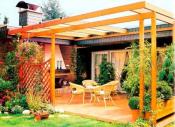Search
Login
Do-it-yourself glazing of balconies and loggias
We always lack square meters for housing, where to get the missing area? But often, balconies and loggias become a warehouse of unnecessary things. But if you glaze this cold room, remove unnecessary trash that will never be useful to you, then this room can be turned into a winter garden or into a cozy living room. We will give you advice and reveal secrets.
Content
- What time of year is suitable for construction
- Window material selection
- Glazing a balcony or loggia in stages video
- Warming of a balcony or loggia video video
- Draft Sealing
- Loggia or balcony heating video
What time of year is suitable for construction
Not every season is suitable for finishing a loggia and balcony, since not all building and finishing materials can be used in wet and cold weather. Therefore, if you decide to do the improvement of a balcony or loggia, solve these issues in the warm season.
Window material selection
When choosing a material for glazing, basic knowledge is required. Using them, you will make the right decision.
aluminum windows
The cheapest installation are aluminum window systems. Aluminum windows are durable and resistant to microorganisms, resistant to fire.
But aluminum structures due to high thermal conductivity will not be able to make your object warm, the temperature on the balcony or in the loggia will be higher than the street temperature by only 3-5 degrees.
And this is the main reason for the impossibility of using aluminum structures to create comfortable conditions for residential premises. A balcony or loggia glazed using aluminum structures, practically, in the cold season can only be used as a warehouse.
wooden windows
Wooden windows retain heat well, they are environmentally friendly. But the technology of their production is very complex, since modern wooden structures are not made from solid wood, but in order to avoid cracks and deformation of the frame, when the humidity of the surrounding air changes, they are made of glued timber.
In this regard, high-quality wooden windows are very expensive and it is very expensive to use them to protect the balcony or loggia. In addition, it must be taken into account that wood is a combustible material, therefore it must be treated with a special composition.
The disadvantage of wood is its ability to rot, for this they are additionally impregnated with antibacterial agents.
pVC windows
PVC windows (polyvinyl chloride), have proven themselves in use for fencing balconies and loggias.
These windows consist of multi-chamber profiles. With reinforcing metal inserts, they reliably retain heat, are unpretentious, environmentally friendly and durable. But after examining the market for the production of PVC windows, you will understand that the windows are different, they even have different service life, from 40 to 60 years.
What should I look for when choosing PVC windows?
If you decide to convert a balcony or a loggia into a warm room, for example, to make a winter garden or a greenhouse, then windows with one simple glass are not suitable. It must be understood that the number of hollow chambers in a profile is from three to five, and the more of these chambers, the better the heat is retained.
But it is possible to use a single-chamber double-glazed window, but with special low-emission glasses with a vacuum coating. The use of such glasses ensures the passage of solar radiation into the room, at the same time, retains the heat of the room, not letting it into the street.
When creating designs for the glazing of the loggia and balcony, specially designed PVC designs have proven themselves well. Compared to wood, they save heat by 30% more economically, such fences are reinforced with liners so that the frame can withstand a gust of wind, otherwise it will vomit when ventilating, this is very important especially on the upper floors.
To ensure that water does not linger on the protrusions and easily flows down, a profile with rounded edges is used in the frame design.
Glazing a balcony or loggia in stages
The practice of glazing has shown that the most convenient way to install double-glazed windows is to install swing windows. Only this design allows you to very effectively save heat in the loggia or balcony, so that when opening the swing window does not eat up space, it is better to order casements with a minimum width (30-40 cm.).
Installation steps
- first you need to measure the geometry of the walls with the help of a level. Then, an expansion profile is attached to the window boxes, the joint is sealed with a mounting foam;
- special mounting plates are attached to the window boxes, it is necessary to select long screws so that they enter the body of the main profile. A box of the first window is installed in the opening;
- the installed box must be fixed in the opening, then check its position by level. Using a connecting profile and silicone sealant, a joint of adjacent boxes is performed. The created structure is once again aligned in the opening and fixed;
- using polyurethane foam, the assembly seam is neatly filled. Further, in size, an ebb from enameled steel is sawn off;
- after installing the windows, the ebb is fixed, the ends of the profiles are hidden by plastic plugs. If the tide consists of several parts, the joints are pulled together by screws;
- window sashes are hung, the operation of locking hardware is checked. The opening stoppers are screwed, the masking tape is glued to the wall and, on the outside, neatly, the mounting seam is putty. As a working solution, tile glue is used.
Warming of a balcony or loggia
It is necessary to insulate the floor, walls, ceiling, while the material should not get wet or burn. Along the perimeter, the contour of the balcony or loggia is closed with a heater, floor and ceiling are also insulated.
In order not to create unnecessary loads on the floors, it should be light and have low thermal conductivity. The choice of heat-insulating materials is great, but experts recommend the use of foil-isolone - this is a special porous polyethylene coated with a lavsan film with a layer of metal spraying.
Having a thickness of only 8 mm., It is able to retain heat as well as a wall in a brick floor. In addition, it does not accumulate moisture, reflects ultraviolet light, and prevents the formation of condensate.
Draft Sealing
Sealing of cracks, gaps, seams and joints formed as a result of improvement should be carried out using special mounting foam or sealant (Emfimastic PU, Macroflex, Rabberflex).
Loggia or balcony heating
Building codes forbid central heating to the balcony or loggia, but if the room is sufficiently well insulated, it can be heated using a room radiator through an open balcony door, and you can install a floor with an electric heating system.
An alternative type of heating is possible using an electric fireplace, air heater, oil cooler.





